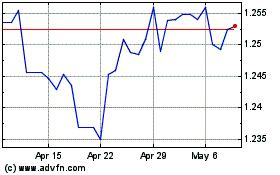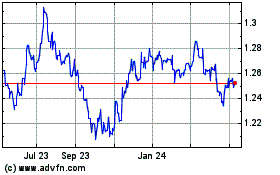Pound Slides On Disappointing U.K. GDP Data
15 November 2024 - 4:51PM
RTTF2
The British pound weakened against other major currencies in the
European session on Friday, after data showed a sharp slowdown in
the third quarter growth.
Data from the Office for National Statistics showed that the
U.K. economy grew only marginally in the third quarter on weak
services output.
Gross domestic product grew 0.1 percent sequentially, following
growth of 0.5 percent in the second quarter and was also weaker
than the forecast of 0.2 percent.
On a yearly basis, economic growth improved to 1.0 percent in
the third quarter from 0.7 percent in the preceding period.
In September, GDP edged down 0.1 percent, in contrast to the 0.2
percent expansion in August, data showed. The economy was expected
to grow again by 0.2 percent.
Earlier this month, the Bank of England had reduced its
benchmark rate by a quarter-point and signaled a gradual easing as
the Autumn Budget is forecast to boost inflation.
Month-on-month, industrial production slid unexpectedly by 0.5
percent in September but slower than the 0.7 percent drop in
August. Output was expected to rise 0.1 percent. Manufacturing
contracted 1.0 percent, partially offsetting the 1.3 percent rise
in August. Economists had forecast nil growth.
In a separate communiqué, the ONS today said the deficit on
goods trade widened in September due to a sharp 12.6 percent
decline in exports. At the same time, imports were down 6.3
percent.
The visible trade deficit rose to GBP 16.3 billion from GBP 15.2
billion in the previous month.
The total trade balance, covering both goods and services,
registered a deficit of GBP 3.47 billion compared to a GBP 2.02
billion shortfall a month ago.
European stocks declined as Federal Reserve Chair Jerome Powell
signaled a cautious approach on rate cuts and mixed Chinese data
stoked concerns about slowing demand in the country.
Powell said the U.S. central bank does not need to rush to lower
interest rates and can approach decisions carefully, given
persistent inflationary pressures.
Data showed earlier today that China's industrial output
expanded at a slower-than-anticipated 5.3 percent in October, while
retail sales jumped an annual 4.8 percent to surpass expectations
boosted by a week-long holiday and the annual Singles' Day shopping
festival.
Property investment fell 10.3 percent year-on-year in
January-October and fixed asset investment growth in the first ten
months of 2024 came in below expectations, keeping alive calls for
Beijing to unveil more stimulus.
In the European trading today, the pound fell to a 9-day low of
0.8350 against the euro and a 2-day low of 1.1229 against the Swiss
franc, from early high of 0.8312 and 1.1281, respectively. If the
pound extends its downtrend, it is likely to find support around
0.84 against the euro and 1.11 against the franc.
Against the yen, the pound slid to a 2-week low of 196.47 from
an early 4-day high of 198.45. On the downside, 193.00 is seen as
the next support level for the pound.
The pound edged down to 1.2649 against the U.S. dollar, from an
early high of 1.2691. The next possible downside target for the
pound is seen around the 1.22 region.
Looking ahead, Canada manufacturing sales, new motor vehicle
sales and wholesale sales data, all for September, U.S. retail
sales data for October, import and export prices for October, U.S.
NY Empire State manufacturing index for November, U.S. industrial
and manufacturing production for October, business inventories for
September and U.S. Baker Hughes oil rig count data are slated for
release in the New York session.
Sterling vs US Dollar (FX:GBPUSD)
Forex Chart
From Nov 2024 to Dec 2024

Sterling vs US Dollar (FX:GBPUSD)
Forex Chart
From Dec 2023 to Dec 2024
